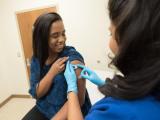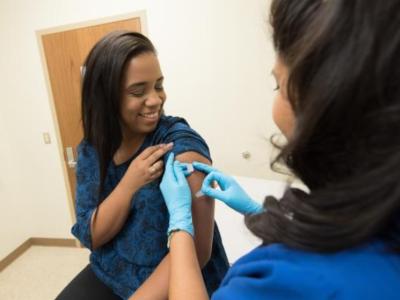Editor’s Note: This article covers research conducted by CIDRAP scientists. Please note that CIDRAP News operates independently in relation to CIDRAP's research and policy programs.
Oct 15, 2012 (CIDRAP News) – A report released today (see related CIDRAP News story) that urges a new course for seasonal and pandemic flu vaccines started as a fairly straightforward review of the 2009 H1N1 vaccine but ended up putting the whole flu vaccine enterprise under the microscope, with some unexpected findings.
Momentum for the project first came from the Alfred P. Sloan Foundation, which in December 2009 provided a 1-year grant to the University of Minnesota's Center for Infectious Disease Research and Policy (CIDRAP) to study the pandemic vaccine, which by then was in ample supply for adults as virus activity was starting to decline in several states.
CIDRAP Director Michael T. Osterholm, PhD, MPH, who led the CIDRAP Comprehensive Influenza Vaccine Initiative (CCIVI) research team, said the group realized early in its work that to fully characterize the 2009 H1N1 vaccine, they needed to understand how well it worked, explore its availability, and gauge how people used it.
"With each of those issues, the more we peeled the onion back, the bigger the project got and the more issues we addressed," he said. CIDRAP also publishes CIDRAP News.
Originally, the Sloan Foundation work was supposed to take 1 year, but the researchers kept finding more unanswered questions, prompting CIDRAP researchers to continue the work on their own over an additional 2 years.
In October 2011 some members of the group, including Osterholm, previewed a small part of their findings in a meta-analysis in Lancet Infectious Diseases. The rigorous review of 44 years of flu vaccine studies raised questions about seasonal vaccine effectiveness, especially in older people who are at greatest risk of death from flu.
Osterholm said he's not aware of any other report on a vaccine that takes the cradle-to-grave approach that his team used to explore the flu vaccines and the policies that have been used over the years to recommend them. "In a sense, the vaccine is in a category by itself; it's the only one universally recommended and receives by far the most promotion of any vaccine across all ages," he said.
The group combed through more than 12,000 articles, transcripts, and notes that date back to 1936, which include scientific studies, government advisory group statements and meeting records, as well as documents from a host of governments around the world and global public health groups such as the World Health Organization (WHO).
CCIVI researchers supplemented their findings with interviews with 88 experts on influenza vaccine research, development, and use. Osterholm's group also tapped the expertise of a 13-member expert advisory group (EAG) that included not only scientific and industry experts, but also public health experts with no formal ties to vaccines.
The EAG held two meetings in Washington, DC, where the group heard from science, industry, and government experts on topics that ranged from new approaches to vaccine safety and distribution.
Osterholm said the CCIVI team was surprised to find a lack of understanding of how well flu vaccines work from year to year. He said another unexpected finding was that misperceptions about vaccine effectiveness are barriers to investments in novel-antigen vaccine research and development. "We clearly confirmed that [finding] with the investment community and the pharmaceutical industry," he said. "We found a general perception that we don't need a better flu vaccine, we just need to make more of it faster."
Al Sommer, MD, MHS, professor and dean emeritus of Johns Hopkins Bloomberg School of Public Health, said he was initially surprised when Osterholm asked him to chair CCIVI's EAG, given that he had no specific expertise in flu vaccines.
Sommer's main areas of expertise are ophthalmology and epidemiology, and his research on vitamin A in the 1970s and 1980s led to recognition that treating vitamin A-deficient children with inexpensive large-dose capsules twice a year could reduce child mortality by as much as a third.
However, Sommer said Osterholm told him his degrees of separation from the topic of flu would help provide some useful third-party observations, because those who are closely involved may hold strong opinions. Upon seeing the results of the CCIVI research, Sommer observed, "I was able to grasp, from among the excellent presentations and engaged discussions, that 'the emperor had no clothes,' "
The initial findings of official reports on lessons learned from the 2009 H1N1 pandemic have focused largely on the need for a new platform to speed the production of the vaccine, he said. The CCIVI group's efforts to document as rigorously as possible the value and effectiveness of current vaccines produced a startling conclusion that influenza vaccines are not only cumbersome to produce, but even in seasons when there is a strong match between the vaccine and circulating strains, "the benefit in terms of lives saved, which essentially meant the elderly, was minimal at best," Sommer said.
Efficacy gaps and cumbersome production requirements meant that the primary issue had to be a major investment of money and effort to create a radically new vaccine, he said. "One that conferred greater protection for those most likely to become seriously ill and die, but also one that would not need to be reformulated and administered so frequently."
Peter Sandman, PhD, a member of the CCIVI EAG and a risk-communication consultant based in Princeton, N.J., said the group's focus shifted over time, broadening in some ways and narrowing in others. The group seemed poised to produce a technical report that detailed inadequacies of current flu vaccines and how they're produced. "But then the research moved in an unexpected direction, one much closer to my field," he said, pointing to the team's investigation that revealed how flu vaccine recommendations lacked a strong scientific basis, leading to misperceptions that carried through in messages to the public.
"I'm not qualified to assess the report's position on the feasibility of a game changer, but I do think the report will carry the day on the need for a game changer," Sandman said. "I look forward to a serious discussion of the report's assessment of the barriers to a game-changing flu vaccine and how those barriers can best be overcome."
Sandman said it's difficult to gauge what impact the report might have on public health or consumer perceptions. He said the best outcome would be if public health leaders change flu vaccine messaging in a way that openly acknowledges that the vaccine works only about 60% of the time for healthy adults, while stressing that that is still a major benefit.
The next bullet point would be an acknowledgement that 60% isn't good enough, and the science community needs to work harder to develop a more effective vaccine, he added.
"If this is the messaging that's cascaded down to state and local officials and individual doctors, I think the public will get it," he said.
See also:
CCIVI report
Oct 15 CIDRAP News story "Report: Complacency, misperception stymie quest for better flu vaccines"
Oct 25, 2011, CIDRAP News story "Strict meta-analysis raises questions about flu vaccine efficacy"


















